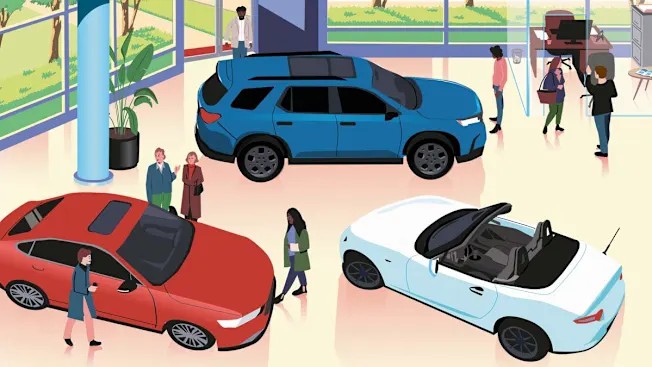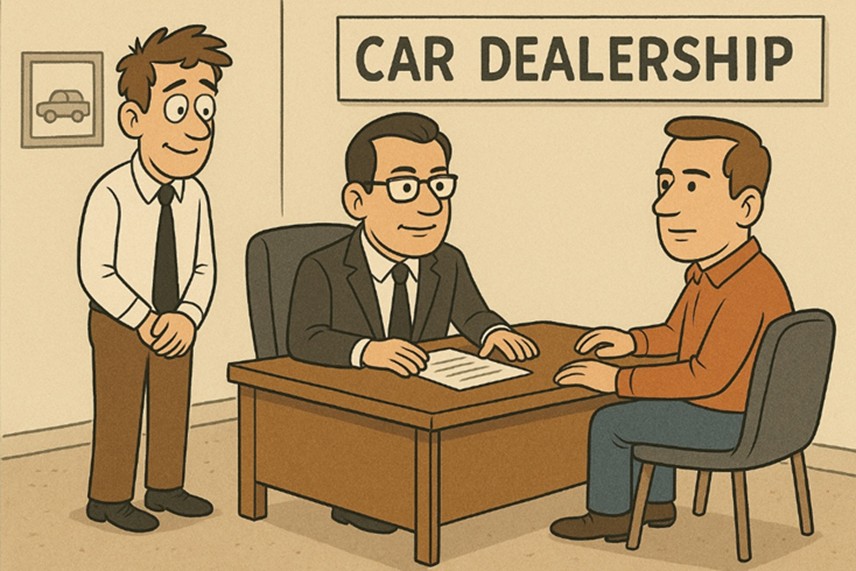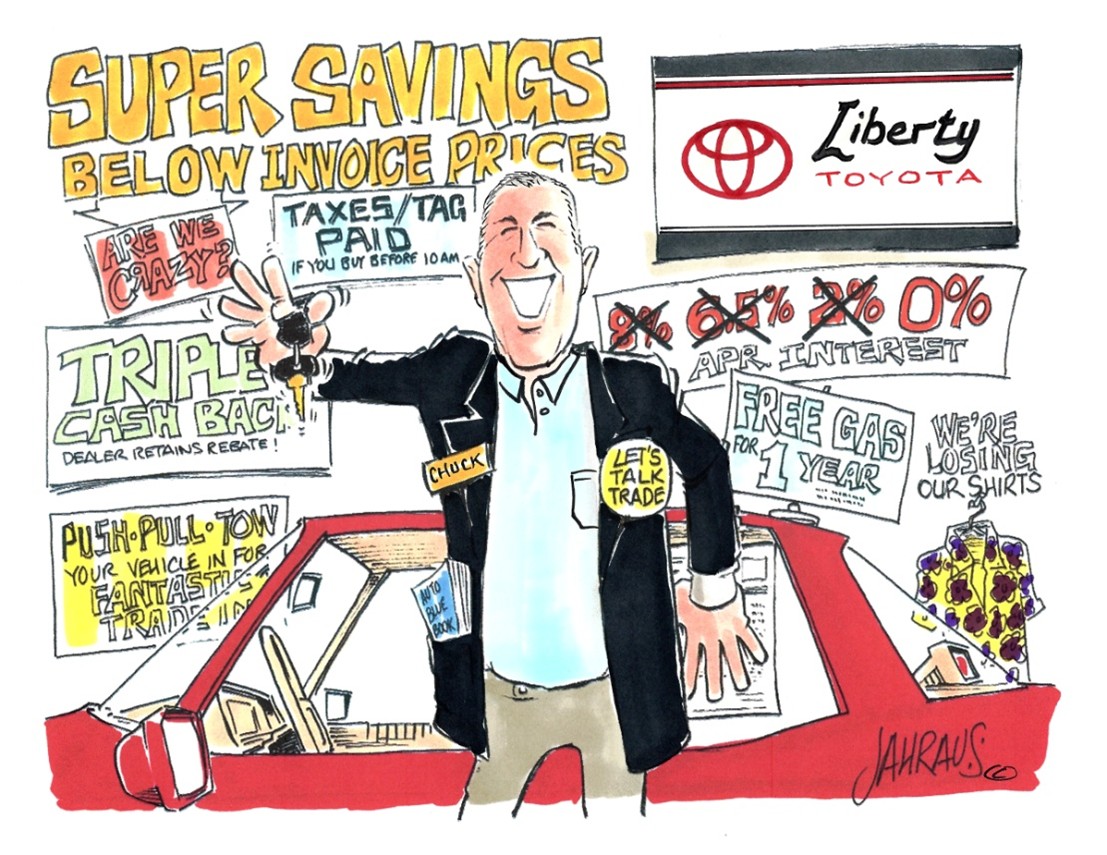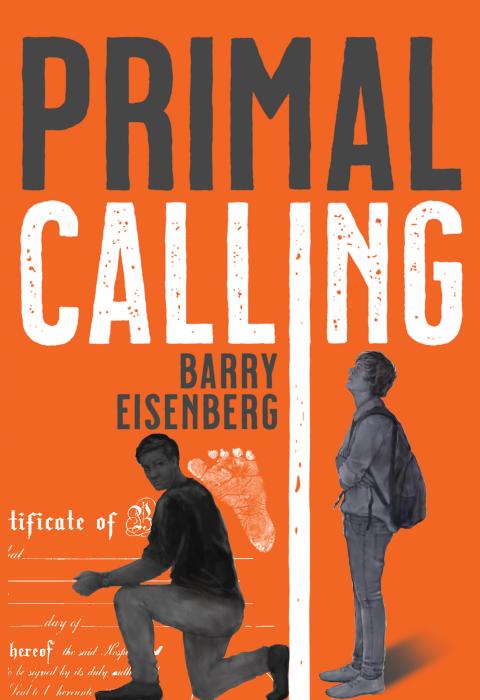“Let Me Get My Manager” – The Strange Theater of Buying a Car
Buying a new car is fun, right? There’s the fresh smell of new upholstery, the shimmering gloss of showroom floors, and that little thrill you get imagining yourself behind the wheel, windows down, music up. It's the adult version of picking out a new toy.
So, when my friend Greg told me he was thinking about getting a new car, I jumped at the chance to tag along.
“Come on,” I said, “Let’s hit the dealerships this weekend. I love this stuff.”
Greg raised an eyebrow. “You like spending your Saturday watching salespeople try to push all-weather floor mats and a crazy expensive upgraded warranty on you?” (When did Greg go from a happy-go-lucky to a glass half-empty kind of guy?)
“No,” I grinned. “I like watching them work. It’s like theater, although I could pass on the tedium of all that paperwork.”
Saturday rolled around and there we were, approaching the polished glass doors of a local dealership, an average-sized place with strategically angled gleaming sedans and SUVs. They’d been buffed to the point of blinding, like the cars were auditioning to be solar panels.
Even before we were fully through the doorway, a man in a collared shirt and khakis pointedly came our way, doing his best to appear nonchalant.
“Hi folks!” he said, cheerfully and with some well-rehearsed enthusiasm. “Welcome! What brings you in today?”
“Just starting to look,” Greg replied good naturedly. “Thinking about a hybrid SUV.”
“Perfect,” the salesperson exclaimed, already motioning us toward his desk. “My name’s Mike, and I’d love to help you out today. Let’s just take a quick seat and I’ll get some info, see what you’re looking for, maybe get you out for a test drive.”
And just like that, Greg, whose only intention was to browse, was sitting at a desk, handing over his driver’s license, and answering questions like, “What are you trading in?” and “What kind of budget are we working with?”
I leaned over and whispered, “Seems like you’re already halfway to buying the car, and we haven’t even looked at one!”
Greg chuckled. “Yeah, next thing they’ll ask for is my checkbook.”
But that’s the whole point, isn’t it? The moment you hand over your ID and settle into that chair, you’re inching toward the point of no return. It’s like stepping onto a moving walkway that quietly transports you toward the finance office, whether or not you’re ready to buy.
You’re no longer a casual shopper. You’ve leveled up into a serious buyer in the blink of an eye. Make that the blink of a turn signal. With that small move, you’ve taken the bait. Now you’re on the hook being reeled in and the dealership gains some psychological momentum.
We spent the next hour test-driving a couple of SUVs. Greg seemed intrigued but non-committal. And when we finally sat back down at the desk, Mike smiled.
“So, what’d you think?” Mike asked. “That last one’s a real beauty. Rides like a charm. I could tell you loved the screen, simple to use but it’s got all the right bells and whistles.”
Greg hesitated. “I like it. But I’m not ready to make a decision today. I want to check out a couple other cars first, some of the competitors.”
Mike nodded with the kind of exaggerated empathy they must practice in training. “Of course, of course. We want you to feel that you’re making the right decision. Before you go, though, it would be great for you to chat with my manager for a minute or two. He might be able to show you some numbers that will make it easier for you to compare.”
And there it was, the Turnover. Known as the TO in the industry, it’s that inevitable turning point when the salesperson brings in the higher authority and retreats to a background role.
We watched as Mike walked over to a desk in the corner and leaned in to chat with his manager. From our seats, it looked clearly like a strategy huddle. A few glances in our direction. A couple of nods.
Then both men began walking back.
The manager, slightly older and in a suit jacket, reached out to shake our hands.
“Beautiful day, huh?” he said, before sitting down. In Mike’s chair! The very Mike who’d just spent the last hour with us! And there was Mike, now standing awkwardly to the side, looking less like a professional and more like an intern waiting to fetch a cup of coffee.
“I’m Steve,” the manager said. “Just wanted to check in, make sure you were getting all the info you need. How’s Mike treating you?”
He shot a look up at Mike, who, now depleted of status and siphoned of dignity, smiled sheepishly.
Greg looked a little thrown, as though the person who had been steering him through the process until now needed a lifeline. “Yeah, uh… Mike’s been great. Gave us lots of good information.”
“Well, that’s what I like to hear,” Steve said, a pleased smile crossing his face like he’d just heard that his teenager got a C on a test he expected to fail. “Now, Mike tells me you’re not ready to buy today, which we totally respect. But I want to make sure we don’t miss the opportunity to earn your business. Let me show you what we can do.”
And with that, the “numbers” came spilling out, a cascade of calculations, discounts, trade-in values, and special offers, all making it sound like the car was free. Then came the classic culminating line: “This is a special deal we’re running only this weekend.”
Now here’s the fascinating part.
What just happened wasn’t random. The entire episode – from the greeting at the door and getting Greg’s driver’s license before seeing any cars, all the way to the TO – is all part of a well-established, carefully devised sales strategy that’s been in practice since, well, probably since the first showroom was opened in America.
The idea is simple, and it’s that the salesperson's job isn't really to close the deal. Rather, it's to maneuver the customer to the point where the deal is possible and then hand things over to someone with more perceived authority who can use that superior rank to drive the deal to closure.
As Mike faded into the background like a stagehand, Steve took center stage, controlling the script.
By physically taking the salesperson’s chair, the manager assumes control, not just of the negotiation, but of the social dynamic. Sure, it may be subtle, but it’s very effective. You’re no longer negotiating with someone who’s trying to sell you something. You're negotiating with someone conferred with decision-making clout, who is positioning himself to be on your side, seemingly committed to giving you the “best possible” deal.
If Greg had said he needed a better price, Steve could have magically produced a new, more attractive number. If Greg had been hesitant, Steve could have reminded him of the features of the car he said were important to him, nudging Greg to overcome his wavering. If Greg had said no outright, Steve could pivot, sweeten the offer, or draw the conversation out long enough to wear him down.
By this point, the whole game is about leverage and psychology.
The longer you sit, the more emotionally invested you become. You've talked about features. You've imagined driving the car. You’ve met the manager. Walking away now feels… well, harder.
And that’s really what it’s all about.
The TO strategy works by making it tougher for the customer to say no. It introduces a sense of authority by involving a manager, giving the impression that the new proposal is either final or the most optimal offer. This can make you less inclined to negotiate further, and for some shoppers it even creates a sense that walking away would be rude. After all, the manager has been working diligently to come up with the “best possible” deal.
Of course, none of it is accidental. Even the “limited-time offer” is part of the act. The price probably won’t change tomorrow, but the pressure to decide will.
Greg didn’t buy the car that day. He listened politely, thanked Mike and Steve, and said he wanted to sleep on it.
As we walked back to his trusty, slightly sun-faded sedan, he glanced at me and said, “I feel like we were one scene away from a dramatic spotlight and a standing ovation.”
I laughed. “I know, right? All that was missing was the playbill and curtain call.”
In the end, Greg didn’t drive away in the car he admired that day. But he did buy it a couple of weeks later after doing some comparison shopping. Turns out the deal he got from Steve was attractive after all. Maybe even the “best possible” deal.
Buying a car might always come with a bit of drama, but it doesn’t have to feel like you’ve unwittingly stumbled into a dinner theater version of Glengarry Glen Ross.
As Greg and I laughed the day he picked up the car, we agreed – sometimes it's best to just enjoy the show, smile at the performers, and remember, the smartest move is knowing if you should leave before the encore.

